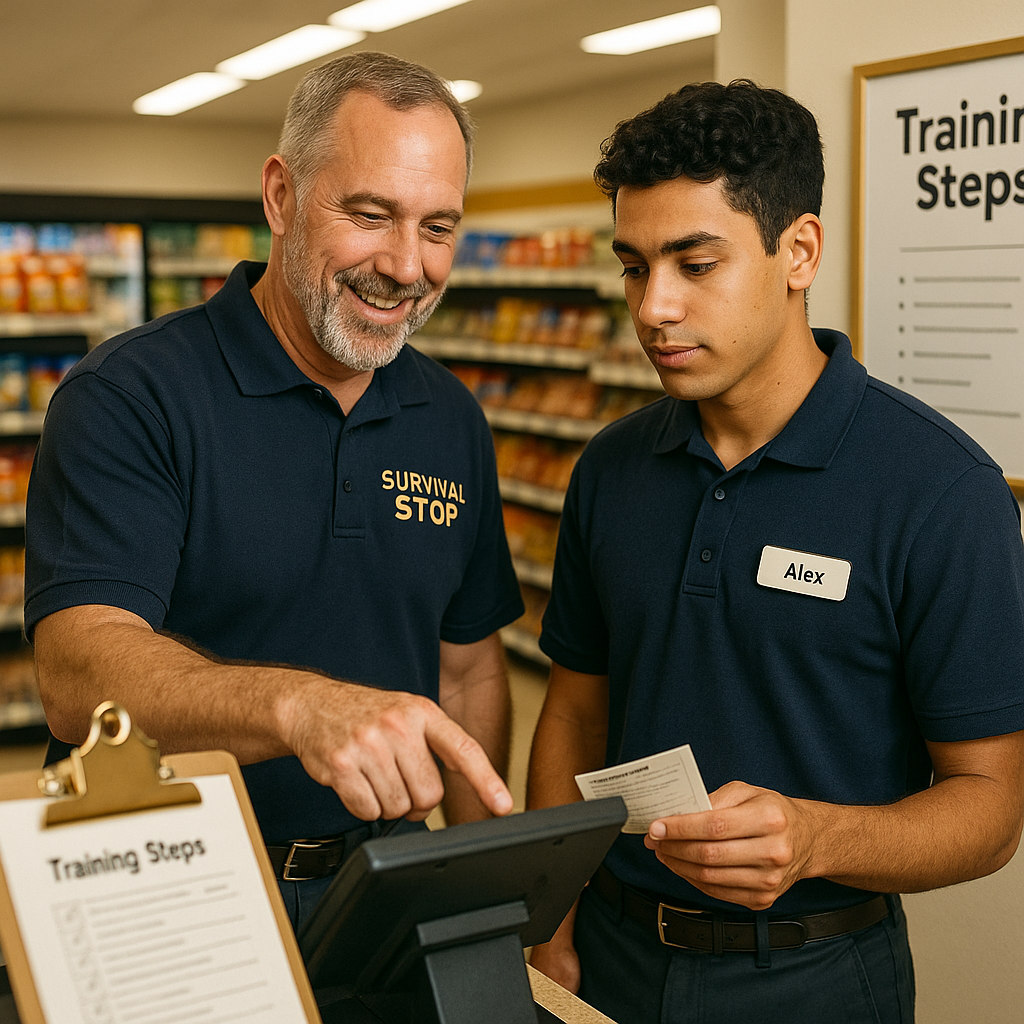How to Train New Convenience Store Employees Quickly
Structured rapid training gets better results than drawn-out processes. The 48-hour competency framework focuses on essential skills that enable new employees to handle basic transactions safely within two days while achieving 65% faster competency development.

Convenience store assistant managers face a constant challenge: getting new employees productive quickly while maintaining daily operations during busy periods. Understanding how to train new convenience store employees quickly can mean the difference between successful onboarding and costly turnover that disrupts customer service and strains existing staff.
"I used to think proper training required days of dedicated time we didn't have," explains Layla Washington, assistant manager at a high-volume Survival Stop location. "Then I learned that structured rapid training actually gets better results than drawn-out processes that never seem to finish."
Industry research indicates that convenience stores using systematic quick-training methods achieve 65 percent faster competency development while reducing new hire turnover by 40 percent compared to informal training approaches.
The 48-Hour Competency Framework
Effective rapid training focuses on essential skills that enable new employees to handle basic transactions safely within two days. This framework prioritizes immediate productivity while building comprehensive knowledge gradually over subsequent weeks.
Day 1: Core Transaction Skills (4 hours) Morning orientation covers basic register operation, cash handling procedures, and age verification protocols. New employees observe experienced workers during the first busy period, then practice simple transactions under close supervision during slower afternoon hours.
Day 2: Product Knowledge and Problem-Solving (4 hours) Focus shifts to product locations, common customer requests, and basic troubleshooting skills. New hires handle more complex transactions while experienced staff provide backup support and guidance.
Camden Torres, whose urban store serves diverse customer needs, emphasizes practical application over theoretical training. "We get new employees processing actual transactions with supervision rather than spending hours on hypothetical scenarios. Real experience builds confidence faster than any manual."
Time-Efficient Training Techniques
Shadow-and-Switch Method: New employees observe for 30 minutes, then handle transactions with experienced workers standing beside them. This approach provides immediate feedback while maintaining normal service flow during busy periods.
Micro-Learning Sessions: Break complex procedures into 10-minute segments taught during natural lulls in customer traffic. Topics include lottery operations, money orders, and fuel system management spread across multiple brief sessions.
Checklist-Driven Progress: Use specific competency checklists that track skill development and identify gaps requiring additional attention. This systematic approach prevents important procedures from being overlooked during compressed training schedules.
Nadia Okafor, who manages training at three locations, credits structured micro-learning with improving retention. "Short, focused training sessions work better than hour-long information dumps that overwhelm new employees and disrupt operations."
Leveraging Peak Period Training
Busy periods provide excellent training opportunities when managed properly. New employees can observe customer flow patterns, product demand cycles, and problem-resolution techniques during real operational conditions that can't be replicated during slow periods.
Controlled Exposure: Position new hires where they can observe but not obstruct experienced workers during rushes. This exposure builds understanding of pace expectations and multitasking requirements.
Immediate Application: After observing busy period operations, new employees practice similar transactions during quieter moments while the experience remains fresh.
Technology-Assisted Rapid Training
Modern training tools accelerate competency development while reducing supervision requirements. Video tutorials accessed via smartphones enable new employees to review procedures independently during breaks or slow periods.
Digital checklists and training apps provide structured learning paths that new employees can complete at their own pace while ensuring consistent coverage of essential skills.
Joaquin Rivera, assistant manager at a 24-hour location, emphasizes technology's role in efficient training. "Our training app lets new employees review procedures between customers instead of waiting for dedicated training time that's hard to find during busy operations."
Quality Control and Assessment
Rapid training requires systematic assessment to ensure competency without compromising safety or compliance. Brief daily check-ins with new employees help identify knowledge gaps early while reinforcing positive performance.
Skills Verification: Test specific competencies like age verification, cash counting, and emergency procedures through role-playing exercises that take only minutes to complete.
Feedback Integration: Provide immediate feedback during actual transactions rather than waiting for formal review sessions that may come too late to prevent habit formation.
Understanding how to train new convenience store employees quickly requires balancing speed with thoroughness. Assistant managers who master rapid training techniques can maintain operational efficiency while building competent teams that provide excellent customer service from day one.
The key lies in systematic approaches that maximize learning during available time rather than hoping for ideal training conditions that rarely exist in busy convenience store environments.





